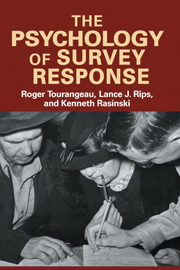Book contents
- Frontmatter
- Contents
- Preface
- 1 An Introduction and a Point of View
- 2 Respondents' Understanding of Survey Questions
- 3 The Role of Memory in Survey Responding
- 4 Answering Questions about Dates and Durations
- 5 Factual Judgments and Numerical Estimates
- 6 Attitude Questions
- 7 Attitude Judgments and Context Effects
- 8 Selecting a Response: Mapping Judgments to Survey Answers
- 9 Editing of Responses: Reporting about Sensitive Topics
- 10 Mode of Data Collection
- 11 Impact of Cognitive Models on Survey Measurement
- References
- Author Index
- Subject Index
7 - Attitude Judgments and Context Effects
Published online by Cambridge University Press: 05 June 2012
- Frontmatter
- Contents
- Preface
- 1 An Introduction and a Point of View
- 2 Respondents' Understanding of Survey Questions
- 3 The Role of Memory in Survey Responding
- 4 Answering Questions about Dates and Durations
- 5 Factual Judgments and Numerical Estimates
- 6 Attitude Questions
- 7 Attitude Judgments and Context Effects
- 8 Selecting a Response: Mapping Judgments to Survey Answers
- 9 Editing of Responses: Reporting about Sensitive Topics
- 10 Mode of Data Collection
- 11 Impact of Cognitive Models on Survey Measurement
- References
- Author Index
- Subject Index
Summary
The view of attitudes presented in the preceding chapter implies that attitude judgments are temporary constructions (Wilson & Hodges, 1992). They may rest on long-standing evaluations and beliefs about a topic, but the judgments themselves must often be created in response to a question, sometimes quite quickly. Moreover, the judgments called for by attitude questions are rarely absolute but are typically made in relation to some standard, generally an implicit one. It is hardly surprising, then, that attitude judgments turn out to be quite context-dependent. As survey researchers have demonstrated repeatedly, the same question often produces quite different answers, depending on the context (see Bradburn, 1982, and Schuman & Presser, 1981, for numerous survey examples). To cite just one particularly well-documented example, the level of support expressed for legal abortions when the “woman is married and does not want any more children” depends on whether that question comes before or after a similar question on abortion when “there is a strong chance of a serious defect in the baby” (Schuman, 1992; Schuman & Presser, 1981). Asking the birth defect question first can greatly reduce support for abortion for married women who simply don't want any more children.
According to the belief-sampling model, the stability of attitude responses across different occasions or contexts largely reflects three factors – the homogeneity of the underlying pool of considerations related to the topic, the overlap in the samples of considerations that are the basis for responses to the different questions (or the same question in different contexts), and the reliability of the process of evaluating these considerations.
- Type
- Chapter
- Information
- The Psychology of Survey Response , pp. 197 - 229Publisher: Cambridge University PressPrint publication year: 2000
- 2
- Cited by



